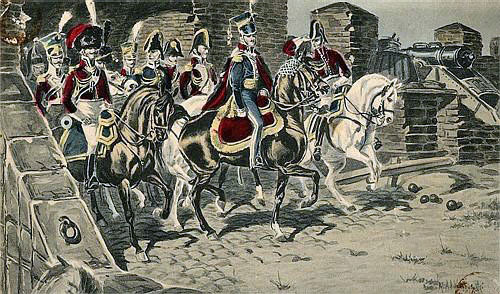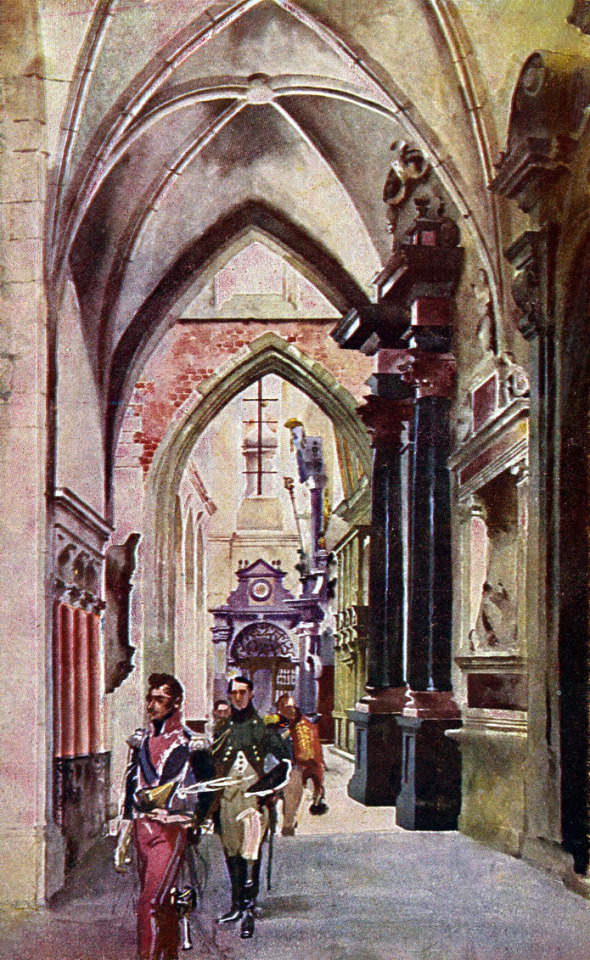Dog Waiting For His Friend
Dog waiting for his friend
(via)
More Posts from Topchubashi and Others
The Galician campaign of 1809
Today let me tell you a little bit about the Galician campaign of the Austro-Polish war of 1809, which proved to be a great success for the Duchy of Warsaw.
After the battle of Raszyn there happened the series of small battles, which prevented Austrians from crossing the Vistula, thus leaving the initiative on the right bank of the river firmly with the Poles. So, the Polish forces under Poniatowski’s command moved along Vistula to the South-East, to the lands Austria seized during the latest partition of Poland.
On the 14th of May the Polish Army entered Lublin:

Konstanty Gorski, “Prince Józef Poniatowski enters conquered Lublin in 1809, showered with flowers by ladies”
As Kajetan Koźmian recalls in his memoirs, Poniatowski and his men were greeted with “joy and elation”, and in the evening “… the city and the citizens gave a great ball <…> in the house in Korce. Prince Józef honored them with his presence starting the ball.”
The next city on the way of the Polish Army was Sandomierz, and after a short siege it was taken on the 18th of May.

Siege of Sandomierz in 1809.

Michał Stachowicz, a scene from the battles in Galicia (“The Capture of Zamość”)
Then there was Zamość, where the Polish trooped entered on the 20th of May.

Siege of 1809, M. Adamczewski Entry of Prince Poniatowski to Zamość (postcard)
On the 27th of May the Polish advanced forces even reached the city of Lwów, but prince Józef wasn’t among them.
Meanwhile the Austrians under command Archduke Ferdinand realized the precariousness of their position in the center of Poland, and on the 1st of June left Warsaw for the south.
Poniatowski, for his part, decided not to engage with the Austrian, focusing instead on “liberating” as much Galician land as possible.

Prince Józef Poniatowski seeks information from local peasants in Galicia in 1809, a photo of Stanisław Bagieński’s painting
On the 3rd June there appeared the third participant of the events - Russian forces crossed the Austrian border to Galicia as well. And though formally they were acting as Napoleon’s ally, as was prescribed in the Tilsit Treaty, their real goal was to prevent the Poles from taking too much of the Austrian-held territories.
So, to outwit the Russians prince Józef was taking Galician cities not in the name of the Duchy of Warsaw, but in the one of emperor of the Frenchmen. Like the proclamations were being made in the name of Napoleon, the eagles on the coats-of-arms replacing the Austrian ones were not Polish and French etc.

Lancers lead Austrian prisoners of war near Kraków in 1809, in front of Prince Józef Poniatowski, a photo of Stanisław Bagieński’s painting
Then, in the outer theater of war on the 6th of July the French defeated the Austrians at the Battle of Wagram. And according Franco-Austrian truce signed five days later the land division was to take place along the line where the troops were at the time of receiving news of the truce, not at the time its signing.

The Austrian army leaves Wawel, a postcard based on the painting of Wojciech Kossak
And so began the race between Russians and Poles, to advance to as farther as possible.
In the middle of July both armies reached Kraków.

PRINCE JOSEPH’S ENTRY TO KRAKOW. A drawing by Jan Feliks Piwarski.
And there the clash of the interest took place.
Poniatowski approached the city from the side of St. Florian’s Gate, but it turned out that the Austrians, wanting more comfortable terms of capitulation, had already let Russian troops into Kraków.
The Russians, namely the Cossacks of General Sievers, wanted to deny Poniatowski passage. But Prince Józef, as Dezydery Chłapowski recalls in his memoirs, "draw his broadsword and with together his staff galloped into the gate through the Cossacks”. The Polish infantry followed its commander “in a double step <…> so that the Cossacks were pressed against the walls of the gate.” Seeing this, Mariampol’s hussar regiment, which was stationed at that time in the market square, make a decision to put up resistance and due to this, the whole Polish army was able to enter the city.

Michał Stachowicz, The entry of Prince Józef Poniatowski into Krakow on July 15, 1809
Then, as Ambroży Grabowski recalled, when prince Józef’s troops reached the market square, “in front of the church of St. Wojciech, the magistrate went out to meet the prince, to give him the keys of the city”.

Józef Poniatowski in the Cathedral after Kraków was taken from the Austrians, an image by Stanisław Tondos and Wojciech Kossak
Most probably prince Józef visited the Wawel cathedral during his sojourn in Kraków that time. (In a small voice: little did he know that in 8 years he’ll be buried there…)
And after exactly a month since the Polish troops entered Kraków, there was a ball arranged in the Cloth-hall, the image depicting it I have already posted here.

Naval hat, age and country of origin unknown - possibly, England, early 19th century









schembart carnival costumes
illustrations from a schembartbuch, depicting costumes from the nuremberg 'schembartlauf' festival from the years 1449 to 1539. nuremberg, c. 1551-1600
source: Nuremberg, GNM, Hs 5664

Schooner THOMAS W. LAWSON, 1902. The only 7 masted schooner ever built. Could sail 16-18 nots, faster than steamships of the time at ~ 9 knots. She carried primarily coal and oil in barrels. She sank off the Isles of Scilly, in a storm on Friday, 13th of December, 1907, killing all but two of her crew of eighteen and a harbor pilot. Her cargo of 58,000 barrels of light paraffin oil caused one of the first large marine oil spills. Thomas William Lawson (February 26, 1857 – February 7, 1925)[1] was an American businessman and writer. Lawson, who was intensely superstitious, wrote the novel "Friday the Thirteenth".

V.Yarkin. "Rendezvous of the Russian squadron near Malta"
-
 d4ddy-691 liked this · 1 month ago
d4ddy-691 liked this · 1 month ago -
 bigbromelvin reblogged this · 1 month ago
bigbromelvin reblogged this · 1 month ago -
 pissed143 liked this · 9 months ago
pissed143 liked this · 9 months ago -
 yomismoahora liked this · 9 months ago
yomismoahora liked this · 9 months ago -
 akaleilovesanimals reblogged this · 1 year ago
akaleilovesanimals reblogged this · 1 year ago -
 purple-fangirl reblogged this · 1 year ago
purple-fangirl reblogged this · 1 year ago -
 items-inventory reblogged this · 1 year ago
items-inventory reblogged this · 1 year ago -
 sortyourlifeoutmate reblogged this · 1 year ago
sortyourlifeoutmate reblogged this · 1 year ago -
 unluckyh reblogged this · 1 year ago
unluckyh reblogged this · 1 year ago -
 gstodd895 liked this · 1 year ago
gstodd895 liked this · 1 year ago -
 mickymoon reblogged this · 1 year ago
mickymoon reblogged this · 1 year ago -
 somefrecklyginger reblogged this · 1 year ago
somefrecklyginger reblogged this · 1 year ago -
 5haelin liked this · 1 year ago
5haelin liked this · 1 year ago -
 thenatureofbears reblogged this · 1 year ago
thenatureofbears reblogged this · 1 year ago -
 yoshitora reblogged this · 1 year ago
yoshitora reblogged this · 1 year ago -
 latvian-spider reblogged this · 1 year ago
latvian-spider reblogged this · 1 year ago -
 myalteredstates reblogged this · 2 years ago
myalteredstates reblogged this · 2 years ago -
 topchubashi liked this · 2 years ago
topchubashi liked this · 2 years ago -
 catgirl-bartender reblogged this · 2 years ago
catgirl-bartender reblogged this · 2 years ago -
 mephystos reblogged this · 2 years ago
mephystos reblogged this · 2 years ago -
 vladimarinas-blog liked this · 2 years ago
vladimarinas-blog liked this · 2 years ago -
 mallymun reblogged this · 2 years ago
mallymun reblogged this · 2 years ago -
 pannyexpress liked this · 2 years ago
pannyexpress liked this · 2 years ago -
 mercelot reblogged this · 2 years ago
mercelot reblogged this · 2 years ago -
 the-devils-keeper reblogged this · 2 years ago
the-devils-keeper reblogged this · 2 years ago -
 jessdean liked this · 2 years ago
jessdean liked this · 2 years ago -
 key-the-kitty reblogged this · 2 years ago
key-the-kitty reblogged this · 2 years ago -
 serafinadraconis reblogged this · 2 years ago
serafinadraconis reblogged this · 2 years ago -
 serafinadraconis liked this · 2 years ago
serafinadraconis liked this · 2 years ago -
 gracielaposts liked this · 2 years ago
gracielaposts liked this · 2 years ago -
 coping-via-clint-eastwood reblogged this · 2 years ago
coping-via-clint-eastwood reblogged this · 2 years ago -
 coping-via-clint-eastwood liked this · 2 years ago
coping-via-clint-eastwood liked this · 2 years ago -
 binders-and-beanies reblogged this · 2 years ago
binders-and-beanies reblogged this · 2 years ago -
 melacka reblogged this · 2 years ago
melacka reblogged this · 2 years ago -
 emily-roberts liked this · 2 years ago
emily-roberts liked this · 2 years ago -
 pleasantlystarstruckmaker-blog liked this · 2 years ago
pleasantlystarstruckmaker-blog liked this · 2 years ago -
 joesshack2 liked this · 2 years ago
joesshack2 liked this · 2 years ago -
 sinistralcentaur reblogged this · 2 years ago
sinistralcentaur reblogged this · 2 years ago -
 vaithne reblogged this · 2 years ago
vaithne reblogged this · 2 years ago -
 meganecamera liked this · 2 years ago
meganecamera liked this · 2 years ago

